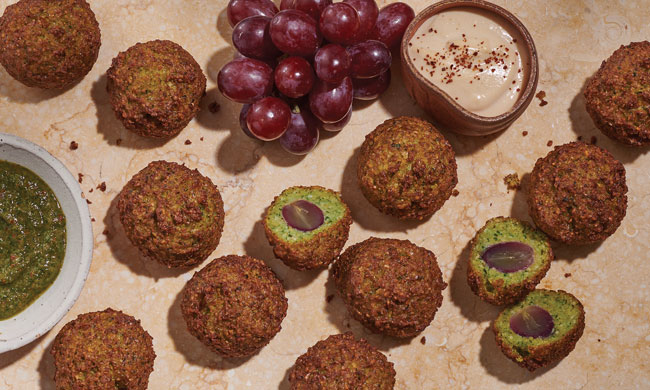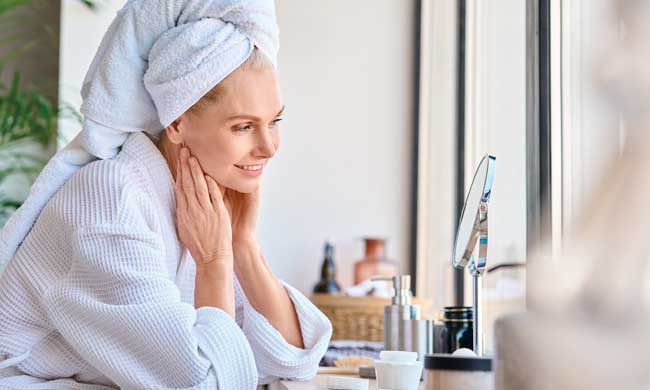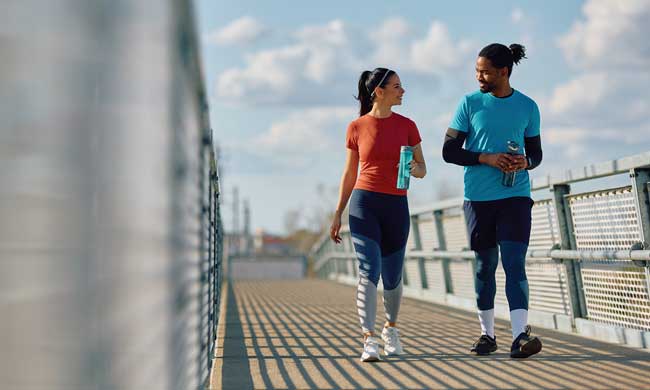HEALTHY LIVING
3 essential steps to love your heart

(Family Features) Taking steps to improve your overall health can help you live a longer, healthier life. One key component of overall well-being – heart health – is especially critical as heart disease has been the leading cause of death among Americans since 1950, according to the Centers for Disease Control and Prevention.
Adopting habits like exercising regularly, eating a heart-healthy diet with lots of vegetables and fruits like grapes and getting the proper amount of sleep can set you on the right path.
Eat a Heart-Healthy Diet
A diet rich in fruits, vegetables, whole grains, lean proteins and healthy fats can have a positive impact on heart health and may lower your risk for heart disease. For example, grapes are easy to keep on hand as a heart-healthy snack. They have no saturated fat or cholesterol and are low in sodium; contain 7% of the daily recommended intake of potassium; and are a good source of vitamin K. Grapes are also a natural source of beneficial antioxidants and other polyphenols and help maintain healthy circulation by promoting the relaxation of blood vessels.
Whether enjoying them by the handful on their own or as part of recipes like these Baked Grape Falafel Bites, where Grapes from California add juicy goodness to a classic chickpea fritter, grapes are a perfect ingredient for heart-friendly eating plans. Research suggests eating grapes daily helps support heart health. In one study, for example, women who consumed 1 1/4 cups of grapes every day benefited from reduced blood triglyceride levels, LDL cholesterol levels, inflammatory proteins and other markers of heart disease.
Exercise Regularly
Getting at least 150 minutes per week of moderate-intensity aerobic activity or 75 minutes of vigorous aerobic activity, as recommended by the American Heart Association, can have a positive impact on heart health by lowering blood pressure, reducing inflammation and aiding in maintaining a healthy weight.
Get the Proper Amount of Sleep
A crucial component of heart health, experts recommend adults get 7-9 hours of sleep each night. Creating a cozy sleep space by turning off electronics and setting the thermostat to a comfortable temperature is the first step toward a restful night’s sleep. Also aim for consistency with your bedtime routine, including going to sleep and waking at the same times each day (including weekends), for best results.
Learn more about the heart-health benefits of grapes, and find additional heart-friendly recipes, at GrapesFromCalifornia.com.

Baked Grape Falafel Bites
- 1 cup dried chickpeas, rinsed
- cold water, for soaking
- 1 cup loosely packed fresh parsley leaves
- 1/2 cup loosely packed fresh cilantro leaves
- 4 garlic cloves, peeled
- 1 medium onion, peeled and cut in wedges
- 1 teaspoon ground cumin
- 1 teaspoon salt
- 1 teaspoon baking powder
- 1/3 cup all-purpose flour
- 18 red Grapes from California
- vegetable oil cooking spray
- tahini sauce or baba ghanoush, for dipping
- In medium bowl, cover chickpeas with at least 2 inches cold water. Let soak at least 12 hours, or overnight, at room temperature.
- To make falafel bites: Drain soaked chickpeas, rinse well in colander and let stand.
- In bowl of food processor, process parsley and cilantro until chopped herbs stick to sides of bowl. Do not scrape down. With motor still running, drop garlic through feed tube; it will also stick to sides of bowl. Remove lid, add onion and pulse to chop well. Add chickpeas, cumin, salt and baking powder. Scrape everything off sides of bowl and process until mixture is well chopped and looks mealy. Add flour and pulse to blend. Cover mixture and chill at least 1 hour.
- Using 1-ounce scoop or tablespoon, drop 2-tablespoon mounds of chickpea mixture onto plate. Shape into balls, stuffing one grape inside each.
- Heat oven to 350 F. Line baking sheet with foil then parchment paper.
- Place falafel balls on sheet and spray with vegetable oil cooking spray. Bake 20 minutes, turning 1-2 times with tongs, until golden brown.
Nutritional information per serving: 240 calories; 8 g protein; 30 g carbohydrates; 11 g fat (41% calories from fat); 1 g saturated fat (4% calories from saturated fat); 0 mg cholesterol; 480 mg sodium; 6 g fiber.
HEALTHY LIVING
How to protect your pet’s dental health

(Family Features) Like humans, pets’ oral hygiene plays an important role in their overall health and quality of life. Common conditions like plaque buildup, tartar and bad breath can escalate to serious health conditions if untreated.
In fact, by the age of 3, 80% of pets experience some form of dental health issue, and the risk only increases as they age. However, for many pet owners, taking care of their four-legged friends’ oral health is a more difficult habit to maintain than their own daily brushing and flossing routine.
Many veterinarians recommend regular brushing for pets, and a wide array of treats and meal additives complement brushing to help support your pet’s oral health.
Protecting your pet’s oral health begins by talking with your veterinarian, who can provide recommendations tailored to your pet’s specific needs. With that guidance, you can start comparison shopping and reading labels so you can identify quality products. Remember you’re likely to find the greatest success by introducing oral health products as part of your pet’s daily routine early on.
Certifications for Trust and Quality
awarded to products that meet strict standards for controlling plaque and tartar. You can find the seal on packaging as an easy visual indication of the product’s quality standards.
Natural, Effective Ingredients
Look for products that prioritize safety and health by offering natural, clinically proven ingredients and no artificial additives or chemicals. Seaweed (or kelp) is a preferred ingredient because it contains minerals and enzymes that help reduce plaque and prevent bacteria.
You can find 100% natural and organic kelp in products like ProDen PlaqueOff®, which includes A.N ProDen®, a kelp ingredient sustainably harvested from specially selected locations in the pristine North Atlantic waters off the Scandinavian coastline. Processed through a specialized method in extreme environmental conditions, it attains peak quality and effectiveness, ensuring safety and health for your pet.
Sustainable Practices
Another detail you can gather from the product’s packaging is whether a product manufacturer adheres to environmentally friendly practices and safe ingredient sourcing, which means the product is not only good for pets but also for the planet. This may be evident in certifications or special icons on the packaging, through information about sustainably harvested ingredients or with packaging that itself is environmentally responsible.
Tailoring to Individual Pets
Different pets have different needs based on age, size, breed and oral health status. Selecting the right product may also be complicated by your pet’s allergies or picky eating habits. You can find a variety of ingestible options, including powders, chews or bones like those offered by ProDen PlaqueOff®, to use in conjunction with daily brushing.
- Powder: Ideal for a seamless addition to your pet’s diet, this is the most economical choice, particularly for long-term use. It’s especially suitable for younger pets as a preventive measure, given its longevity and cost-effectiveness.
- Chews: For those looking for an easy-to-administer option that doubles as a reward, chews are the way to go. Additionally, for older pets or those with missing teeth, soft chews can offer a gentle yet effective way to maintain oral health. They’re a convenient choice for pet owners to give as a daily dose without the need for measuring or mixing.
- Bones: Designed not only to satisfy your dog’s natural chewing instincts but also to aid in dental care, bones are a perfect option for pet parents whose dogs prefer a longer-lasting treat. Bones come in a variety of flavors and sizes, catering to both large and small breeds, making them a versatile way to help keep your dog’s teeth clean and their breath fresh.
Learn more about protecting your pet’s dental health at us.swedencare.com.
Photo courtesy of Shutterstock (veterinarian examining dog)
SOURCE:
Swedencare
HEALTHY LIVING
A guide to great skin at any age

(Family Features) Here’s the secret for achieving a glowing complexion: there is no secret. In fact, a key factor in achieving great skin at any age comes down to one common denominator that’s no secret at all. It’s simply taking good care of your skin.
After all, your skin is your body’s single largest organ. It’s your protective shield, but it can also reveal the truth of your age, especially if you’re lax when it comes to regular skin care.
Make hydration a priority. Keeping the skin hydrated maintains its barrier integrity. When the skin becomes dry, it reduces the effectiveness of the skin barrier, making it less resilient against irritants and allergens.
Often, when the skin is dry it feels more rough or flaky. With proper hydration, the skin feels smoother and looks more supple. Achieving hydration through a better skin care routine, drinking plenty of water daily and eating certain fruits and vegetables can improve your skin’s appearance, maintaining a radiant, healthy complexion.
Use the right soap. Despite what your mother may have told you, squeaky clean isn’t always best. A better bet when it comes to soap is a product that respects your skin’s moisture balance and cleanses without creating tightness or irritation.
Mild options such as Pears skin cleansing products are specifically formulated and dermatologically tested to be gentle on the skin. They’re made with plant-based glycerin, which is a powerful humectant that attracts water from the environment and deeper layers of the skin to the outer layer, keeping it hydrated. Glycerin-based cleansers can help prevent stripping of the skin’s natural oils, which averts a tight, dry feeling.
“More than ever, consumers are looking for mild and gentle products that are effective, smell good and work well,” said Dr. Adriana Lombardi, founder of the Skin Cancer & Cosmetic Surgery Center of New Jersey. “Pears soap checks all the boxes. It creates a really nice, thick lather and smells crisp and clean while leaving the skin hydrated.”
Avoid hot showers. Even the best products may not overcome the potential harm that comes from taking showers that are too hot. The heat removes your skin’s natural oils, which leaves you prone to itching and dryness and may worsen skin conditions.
Instead of cranking up the heat, opt for lukewarm temperatures and keep the shower time brief. Use moisturizing cleansers, and after your shower, immediately apply moisturizer to replenish and rehydrate your skin.
Protect your skin from the sun. After completing your skin cleansing routine, there’s an additional step to help maintain healthy, hydrated skin before heading outdoors: Take time to apply a layer of sunscreen to skin that will be exposed, including your face, ears and hands. Reapply every two hours if you’re spending a great deal of time outside. Sun damage can prematurely age the skin. You may not feel the heat as much during colder times of year, but the rays are still capable of damaging your skin, maybe even more so because you don’t feel the burn
Find more advice for keeping your skin supple and soft at Amazon.com/pears.
3 Steps to Practice a Healthy Skin Routine
- Use a humidifier in your room. Adding moisture to your environment may help prevent over-drying and promote better air quality for your overall health, including your skin.
- Use glycerin-based soap. A glycerin-based soap like Pears gently cleanses your skin without stripping essential moisture.
- Moisturize immediately after showering. Showering, especially at higher water temperatures, can strip your body’s natural oils. Applying lotion immediately after you shower helps retain the moisture your body nee
Photos courtesy of Shutterstock (woman applying moisturizer, man applying moisturizer)
SOURCE:
Pears
HEALTHY LIVING
Harness the power of walking

(Family Features) A walk isn’t just good for your body; it’s a simple, powerful way to care for your mind and soul. Physical activity, like walking, reduces stress, boosts mood and promotes overall well-being. Yet physical activity levels in the United States continue to decline, a trend threatening both mental and physical health.
Less than half of adults and fewer than 1 in 5 children in the U.S. get the recommended amount of physical activity needed for heart health, according to the American Heart Association’s 2025 Heart & Stroke Statistical Update.
National recommendations call for children to get at least one hour of physical activity each day, but the latest statistics show less than 19% of children in the U.S. achieve that target. Meanwhile, less than half of adults get the recommended 150 minutes or more of weekly physical activity.
What’s more, according to data from a National Health and Nutrition Examination Survey, 1 in 4 U.S. adults sits for longer than eight hours each day, which can have negative consequences on physical and mental health.
For decades, the American Heart Association has championed the importance of physical activity in communities across the country through events like National Walking Day on Wednesday, April 2. These tips and information can help you understand how a brisk walk can make a world of difference for heart health and mental clarity.
Benefits of Physical Activity
Staying active is one of the best ways to keep your mind and body healthy.
The physical health benefits may be obvious, but research suggests physical activity can also help bring more joy to your life. According to the 2019 Physical Activity Guidelines for Americans, people who get the recommended amount of physical activity are less likely to experience depression.
Regular physical activity enhances your mood, sharpens your mind, improves sleep and boosts overall well-being, all while reducing the risk of disease and depression and increasing both the quality and longevity of life.
How to Be More Physically Active
Exercise as simple as a brisk walk can put a major spring in your step. It can even energize you to finish other tasks at hand, whether it’s cooking or running errands. Give your daily physical activity level a boost with these tips:
- Exercising outdoors is a great way to get moving. Spending time outdoors has been shown to reduce stress, promote a sense of belonging and improve mood. It’s even better if you can enjoy the sunshine outside, which can improve mood, boost your immunity and help you get some vitamin D.
- Invite a family member or friend along with you. It’s good for them, it’s good for you and it’s good company all around.
- Instead of wondering if you’ll move today, explore how you’ll move. A walk, a dance or a stretch all count.
Getting Pets Involved
Pets are part of your family, and they can help you get healthy together. Pets provide a fun reason to spend more time outside and get the exercise needed to reduce the risk of disease later in life.
Getting moving along with your pet adds more exercise to your routine, which means living longer, reducing risk of dying from heart attack or stroke, reducing risk of diabetes, reducing stress and even boosting your overall happiness and well-being.
Exercising with your pet can also mean enjoying more socializing. You may find yourself meeting other dog owners in your area on a walk or at the dog park.
Learn more about how simple habits like walking can support your overall health at heart.org/MoveMore.
Photos courtesy of Shutterstock
SOURCE:
American Heart Association
-

 NEWS2 years ago
NEWS2 years ago2 hurt, 1 jailed after shooting incident north of Nocona
-

 NEWS1 year ago
NEWS1 year agoSuspect indicted, jailed in Tia Hutson murder
-

 NEWS2 years ago
NEWS2 years agoSO investigating possible murder/suicide
-

 NEWS2 years ago
NEWS2 years agoWreck takes the life of BHS teen, 16
-

 NEWS2 years ago
NEWS2 years agoMurder unsolved – 1 year later Tia Hutson’s family angry, frustrated with no arrest
-

 NEWS2 years ago
NEWS2 years agoSheriff’s office called out to infant’s death
-

 NEWS2 years ago
NEWS2 years agoBowie Police face three-hour standoff after possible domestic fight
-

 NEWS2 years ago
NEWS2 years agoDriver stopped by a man running into the street, robbed at knifepoint







